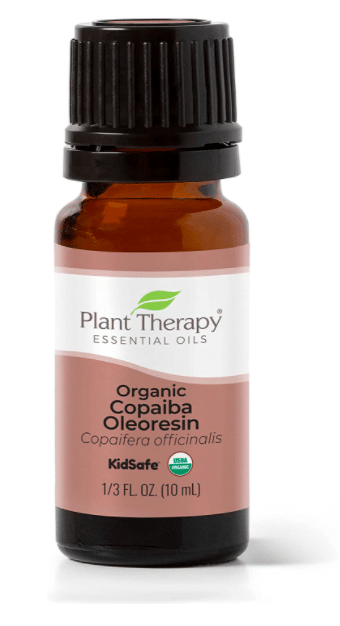We know that certain essential oils can lift our mood and make us happier, but there’s one particular essential oil practically made for our benefit: Copaiba Oil!
How is this possible, you might ask?
Well, today we’re going to go over everything you need to know about copaiba essential oil so that you can use it confidently.
We’ll go over its history, general information about the oil, we’ll explore how it’s used, and to wrap it all up we’ll address some important essential oil safety precautions about using this magnificent essential oil.
Keep reading to learn all about this unique oil and all its wonderful benefits!
Table of Contents
What is Copaiba Essential Oil?
Copaiba essential oil hails from Brazil and is made from the resin of copaiba trees. You may have heard copaiba essential oil referred to as “copaiba balsam”, but this isn’t 100% accurate.
When we mention copaiba oil specifically, we’re referring to the byproduct of copaiba resin.
This is an important distinction to make when making decisions about this medicinal plant since the “Essential Oil” and the “Balsam” aren’t one and the same. Let’s dive in to learn all about this unique tree.
Copaiba Through the Ages: A Detailed History
Copaiba has been around for hundreds of years and was put to use as a medical plant as soon as its healing properties were discovered. One of the first recordings of copaiba resin in European medicine comes around 1625 when it was brought back from the New World (aka South America) by Jesuit settlers who called it “Jesuit Resin”.
Medicinal Uses in the USA
Fast-forwarding a few hundred years, copaiba oil was used in the United States as a disinfectant, diuretic, laxative, and stimulant as well as being used in cosmetics and soaps from 1820 up until 1910.
Today, copaiba oil, similarly to black pepper oil, is still used as a form of tribal medicine in northwest Amazonia, treating everything from skin sores to gonorrhea. It also has uses in Brazilian herbal medicine, where it is employed as a strong antiseptic, expectorant, anti-inflammatory agent, and is even used for cancer treatment.
Copaiba resin (and thereby essential oil) has a rich and long history in South America and beyond. Even today, it continues to be a fantastic treatment for a multitude of ailments
How is Copaiba Oil Made?
Copaiba essential oil is technically an oleoresin, which is a mixture of resin and oil that comes from a plant, in this case, the copaiba tree. This oleoresin is extremely concentrated and requires distillation to separate it into the resin and the essential oil that we are learning about.
Gathered Just Like Maple Syrup…
This oleoresin accumulates in different parts of the plant and can be accessed in a variety of ways. In the case of the copaiba tree, oleoresin is found in cavities within the tree trunk.

To get this oleoresin out, the tree is tapped much like the way in which maple syrup is accessed from trees! Holes are tapped or drilled into the wood of the tree trunk and the oleoresin drips out and is collected.
Copaiba Oil’s Uses and Health Benefits
Anti-Inflammatory Studies
In one study with arthritic rats, systemic inflammation was reduced in arthritic rats that were given Copaiba oil orally compared to arthritic rats that were not treated with this oil.
While this was an animal study and not a human study, these results are still considered promising.
Neurological Studies
Amazingly, copaiba has also proven to be a neuroprotective agent (helping protect nerve cells against damage) as well.

In a 2012 study, copaiba oil resin was studied as having anti-inflammatory and neuroprotective benefits following intense inflammation reactions in the brain and spinal cord. To sum up the study, just one injection of copaiba resin reduced nerve cell damage by about 39%.
Physical Effects Studies
Copaiba oil can also help reduce liver damage. A 2013 study revealed that copaiba oil may be able to reduce liver damage that was caused by over-the-counter painkillers like acetaminophen. The way in which copaiba oil assisted, in this case, was primarily preventative and was not shown to help much after the painkillers were already taken. In fact, copaiba consumed after the painkiller might have caused more harm than good by lowering a liver enzyme level.
Oral Health Studies
Not only that, but copaiba also has a place in oral and dental health care. A study in 2015 tested a copaiba oil resin-based root canal sealer and found that it is not cytotoxic. This means that it is not toxic to living cells and would be a favorable option for root canals.

This is likely because copaiba oil resin is biologically compatible with use in the mouth, has healing properties by nature, and of course, is an anti-inflammatory agent.
Copaiba for Pain Relief
And then we have natural pain relief benefits that come from copaiba essential oil! Scientific research studies have shown that these oils exhibit ‘antinociceptive’ properties. Antinociceptive is a big word that basically means copaiba can help block the detection of pain in the nerves. This development means that copaiba can possibly be used orally to help relieve some ongoing pain like arthritis. Case reports on copaiba and arthritic pain add further support for copaiba as a treatment for arthritis-related pain, but there is limited research on this particular topic.
Copaiba for Acne Relief
Even acne sufferers can reap the benefits of copaiba oil! One study showed very promising results when acne sufferers used copaiba oil topically (applied to the skin); there was a significant reduction in acne.

Consider adding a few drops of copaiba essential oil to witch hazel and spreading it over your face with a cotton pad to reap the skin-enhancing benefits of this essential oil.
Please make sure to perform a small patch test before application, especially if this is an oil you haven’t used before.
Copaiba for Relaxation
Last but not least, copaiba has been known to be nice for relaxing after a long or stressful day with its sweet, woody scent. It can help soothe and wind down before bed.
Copaiba Essentail Oil Recommendations
1. Doterra

DoTERRA Essential Oils Copaiba carries high-quality oils, just like young living essential oils, that their customers swear by. Thankfully, this oil is available on Amazon so you don’t have to go through a distributor to try it!
How to Use
For topical application, dilute 1 to 2 drops with a carrier oil, such as fractioned coconut oil. Perform a small patch test to make sure you don’t get some type of skin irritation with this oil. Then apply all over the desired area.
2. Plant Therapy
Plant Therapy is an affordable essential oil company that doesn’t sacrifice its quality. All their oils are high quality and customers continue to be impressed with them since their oils are also always so affordable. They even provide organic oils at a great price!
How to Use
For topical application, add 1- 2 drops Copaiba and 1-2 drops Frankincense to 1 tablespoon of carrier oil, perform a patch test, and then apply it to any achy joints.
For diffusing, add 1-2 drops of Copaiba, Frankincense, and Clary Sage to a diffuser. This is a great anti-inflammatory mix!
Copaiba vs. CBD
The item of greatest importance when comparing copaiba to CBD is that copaiba is not as well researched. Evidence supporting copaiba’s effects is sparse and the product of uncontrolled clinical observations in humans.
Although there are some studies that look promising like the ones shared above, there is not enough evidence grounded in research to define with certainty copaiba’s effects.
The safety of copaiba is also questionable compared with CBD. Even when individuals are tested with high doses of cannabinol, side effects are rare and mild.
Copaiba is only recommended to be consumed in very low doses because of side effects associated with overconsumption.
Differences & Similarities
One obvious difference between copaiba and CBD is the origin of the oil. Copaiba comes from sap in a tree, while CBD comes directly from the cannabis plant. Because of this, we know that CBD contains several different terpenes that help the body, whereas copaiba is only confirmed to have one.
The strong anti-inflammatory effects of copaiba are where it gets its comparisons to CBD, but CBD is still proven to be a broader spectrum treatment at this juncture.
One similarity that brings CBD and copaiba together is their interaction with the body’s endocannabinoid system. Your body has cannabinoid receptors on the skin, which is why in the intro we mentioned that copaiba can literally make your skin happy! Copaiba contains the molecule beta-caryophyllene, which causes the skin to produce beta-endorphin, one of the happiness hormones!
Copaiba Essential Oil Side Effects
One of the reasons that copaiba is only recommended in small doses is that if over consumed it can cause side effects the mimic food poisoning, reportedly triggering gastrointestinal distress, vomiting, and nausea.
Another potential damaging side effect of using copaiba is liver damage. In one study, copaiba has been seen to cause indications of liver damage after consumption.
There is still more research to be done, but it is important to be aware of these potential side effects.
Always Consult a Physician Before Use
If you have never used this oil before, consult with your physician first (always!)
Then, if you have the green light, be sure to only start with a very small amount so you know how this oil will affect you. Be aware that only one or two drops will suffice to receive the full benefits of copaiba.
Concluding Thoughts
All in all, copaiba oil has a strong array of unique benefits both externally and internally.
Whether you choose to diffuse copaiba and enjoy the relaxing woody and sweet scent, ingest copaiba to take care of your aches and pains, or apply it topically in conjunction with a carrier oil, copaiba has a place in your life!
Give copaiba a try in your essential oil toolkit and see how it works for you!


